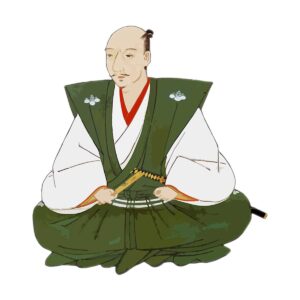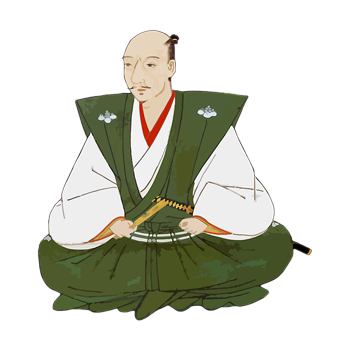
The relationship between the ceramic industry and Nobunaga includes the use of Ming-style tiles during the construction of Azuchi Castle and his influence on tea ceremony utensils, but what is particularly noteworthy is his protection policy for the ceramic industry in Owari and Mino (Aichi and Gifu prefectures). The Nobunaga’s “seifuda” (a set of rules for the production of ceramics) and “shu-in” (a letter of red seal), which are found in various documents, are evidence of his protection of the production industry, breaking with the traditional mercantilism of the time.
Nobunaga’s Seifuda (a seto seal): In the Seto area, Nobunaga’s Seifuda is kept in many houses to prove that the family is an old family. The text reads
Seifuda, Seto
I. Seto goods are not allowed to be sold in the country by merchants from various villages.
I. The white bales and salt-agar products from this township may not enter or leave the country.
(i) That the pawnbrokers in the township of Shinji are not allowed to take pawns.
Those who have violated any of the articles listed above shall be punished accordingly.
December, Eiroku 6 (1563)
The merchants of the various villages engaged in the Seto business are free to come and go as they please throughout the land, and are free to bring grain and marine products to and from the Deai (exchange for Seto goods) market in this province (Seto). If anyone violates these three articles, he or she is to be dealt with immediately. Shirobawarimono are grains and other items exchanged for settlements in lieu of bale goods. Shioaimono is a generic term for salted fish, and today’s isabamono (dried fish, etc.). According to the theory of Shuko Miura, the term “gozoku” or “tokyozoku” refers to a contract between a creditor and a debtor, under which the creditor agrees that if the debtor does not fulfill his/her payment obligations, the creditor may seize the property as soon as he/she finds it, regardless of the time or place, and execute such seizure. A manuscript from the first year of Tempo (1830-44) titled “History of Seto Kiln” states, “Since the middle of Bunsei Era, both seifuda and shoumon (certificates) have been presented at the New Year’s gathering of kiln owners at Ohimachi and served with sake and snacks, and both have been kept in the house of Shinemon Kato Shigesato, the director of new production, and in the house of Sadazo Kato Shigenori, the director of main business, However, since some time ago, both of them have kept them as if they belonged to their own families and have not shown them even at New Year’s since then. The present Shin’emon is the grandson of Shigogo V. The copy has an error in Article 3, “Goshoku shokusoku toshokusoku” as “Gohonen toshokusoku,” and in the last sentence, “Ran” is wrongly written as “Ran” for “Rin,” and one character for “Hi” under “December” is deleted and two characters for “Nobunaga” are added on the Hanaseki. The old Seto households have all made errors, including “Honcho Pottery Novels,” “Wahari no Hana,” “Seto Town Journal,” “Pottery Anthology,” “Nihon Toki Shishi Ron,” “Higashi Kasugai Gunshi,” and “Nihon Tokorashi Shishi. It is likely that the person who originally copied the letter changed it due to a lack of knowledge about seifuda, and that this was gradually passed on to a wider audience.
The letter is in the possession of the Kato Hikoshiro family of Tajimi City, Gifu Prefecture. The text is as follows
Seto pottery kettle
This is a letter from Nobunaga Nobunaga.
The Seto pots can be fired in any other place.
No other pots or kettles are allowed to be made elsewhere.
It is not possible for two people to be on the same page.
Tenkoshiki
New Year’s Day 11th Nobunaga (red seal)
To Shiga Tozaemon.
The red seal letter is accompanied by a document dated 1712 (Shoutoku 2) describing its transmission. According to the letter, Ichizaemon lived in Akazu and then moved to Seto, where he made a tea pot and presented it to Nobunaga in the New Year of 1574 (Tensho 2). He is said to have changed his name to Yosanbei Kagemitsu. According to an old manuscript called “Setogama Denkaku Ki,” Ichizaemon fled to Kusjiri in 1583, and the red seal was later transferred to Tajimi. The agreement was to keep the red seal for one year at a time in each village, and this continued for about ten years, but for some reason it was later discontinued, and the red seal remained in Tajimi. The letter of exchange between the five villages at this time still remains.
The relationship between tea ceremony utensils and Nobunaga, who fell as the middle road to conquer the country, was that he viewed tea ceremony utensils and the tea ceremony as an intermediary between war, politics, and economics. In 1568, when he defeated Hisahide Matsunaga and appointed Yoshiaki Ashikaga to the shogunate, he had Hisahide deliver an eggplant crop and Munehisa Imai, a political merchant in Sakai, deliver a Matsushima jar and an eggplant from Shaoogai. In 1570, he ordered Matsui Tomokan, a deputy governor of Sakai, to collect local specialties, from which he later acquired a picture of Soguryo sweets, a Yakushi-in Komatsushima jar, a Josyu citrus vase, a Ryoun kariguchi vase, a Sokuyu Kaisan Gotoku vase, and others. He also received a chidori incense burner from Ujimasa Imagawa, a pair of kotama-kamen from Kennyo Shonin of Ishiyama Honganji Temple, and a 3-day moon jar from Yoshihon Miyoshi.
Nobunaga also gave these tea utensils to his subordinates for their achievements and licensed the tea ceremony, such as Hideyoshi, who received a kettle and a painting of the moon in 1578 as a prize for his Banshu Keisoku (Banshu Sutra). Takigawa Kazumasa, who was given the title of “Kanto-kanryo” and the town of Umabayashi in Jyoshu as a reward for defeating the Takeda clan, is said to have been saddened that he wanted to have a Juko-ko-nasu tea bowl even if it cost him a castle in a single country. Nobunaga’s tea ceremony was called “Chayu Masamichi,” and it is said that on June 2, 1582, at the time of the Honnoji Incident, thirty-eight famous tea utensils shared Nobunaga’s fate, and this was to hold a tea ceremony to show his treasured collection of tea utensils, which he had previously promised to the Hakata-based tea master Shimai Soshitsu. Later, he built a teahouse in Azuchi Castle with Munehisa Imai, Munenori Tsuda, and Soyui Sen from Sakai as tea masters, and also held tea ceremonies at Shokokuji, Myokoji, and Myokakuji temples in Kyoto.



